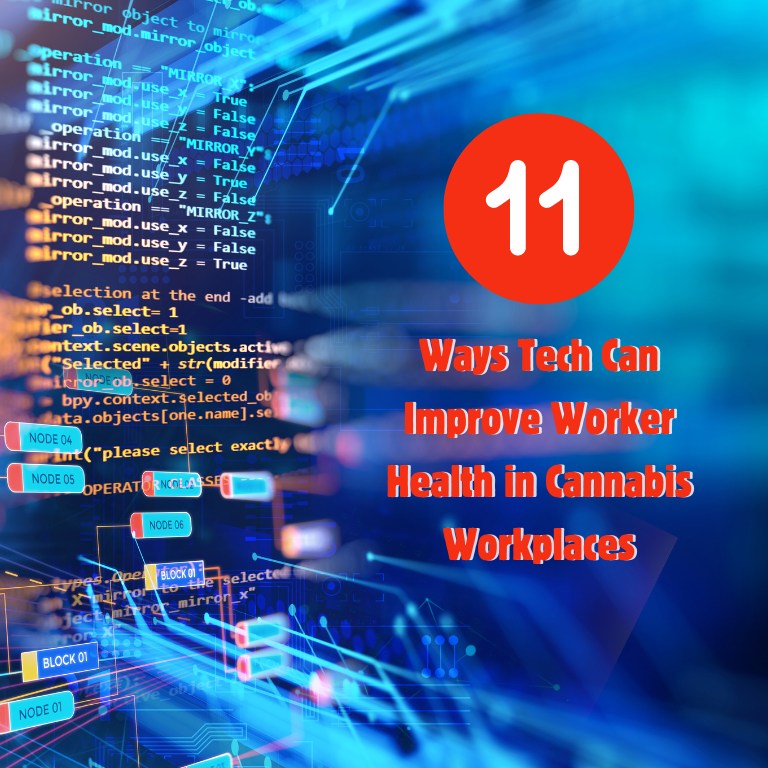11 Ways Tech Can Improve Worker Health in Cannabis Workplaces


The cannabis industry is expanding rapidly, bringing with it a unique set of challenges for worker health and safety. From cultivation and processing to retail and distribution, employees face potential health risks that include exposure to chemicals, repetitive strain injuries, and stress from regulatory demands. Fortunately, technology can play a crucial role in mitigating these risks and improving worker well-being. By integrating innovative tools and systems into cannabis workplaces, businesses can foster safer, healthier environments for their teams. In this article, we explore 11 ways tech can improve worker health in cannabis workplaces.
1. Environmental Monitoring Systems
Cannabis cultivation often occurs in controlled environments, particularly indoor facilities that require precise management of temperature, humidity, and air quality. Poor air quality, whether from inadequate ventilation or high levels of carbon dioxide, can negatively impact worker health, leading to respiratory issues and fatigue.
Environmental monitoring systems use sensors to track and regulate air quality, temperature, and humidity levels in real-time. This technology ensures optimal growing conditions for the plants while also maintaining a healthy environment for employees. Alerts can be set up to notify staff if levels deviate from safe thresholds, allowing for timely interventions.
2. Wearable Technology for Physical Health
Wearable technology, such as smartwatches or fitness trackers, can help workers monitor their physical well-being throughout the workday. These devices can track vital signs like heart rate, detect signs of fatigue, and provide insights into physical exertion.
For cannabis workers engaged in manual labor, such as lifting heavy equipment or working in awkward positions for long periods, wearables can alert them to early signs of strain or injury. This proactive approach allows employees to take breaks or adjust their work habits before minor discomfort turns into a serious injury.
3. Automated Lifting and Handling Equipment
Repetitive tasks, such as lifting heavy materials or transporting products in cultivation facilities and processing plants, pose a risk of musculoskeletal injuries for workers. Automation can greatly reduce these risks by minimizing the need for manual lifting.
Automated lifting equipment, such as robotic arms, conveyor systems, and automated carts, can handle heavy loads, reducing the physical strain on workers. By using machines to do the heavy lifting, employees are less likely to experience injuries like back strain or muscle fatigue, which are common in labor-intensive roles within the cannabis industry.
4. Digital Training Platforms
Effective safety training is key to maintaining a healthy workplace, but traditional in-person training sessions can sometimes be rushed, leading to incomplete understanding. Digital training platforms provide a more flexible, interactive approach to educating workers on safety protocols, health risks, and emergency procedures.
Using virtual training modules, cannabis businesses can offer employees the opportunity to learn at their own pace, reviewing materials as needed to ensure full comprehension. These platforms can also incorporate simulated scenarios, such as handling hazardous chemicals or responding to equipment malfunctions, which prepare workers to manage real-life challenges.
5. Ergonomic Workstations
Ergonomics plays a crucial role in preventing strain and injury, especially for workers who spend extended periods seated or performing repetitive tasks. Tech-enhanced ergonomic solutions can optimize workstations in cannabis production and retail environments.
Adjustable workbenches, height-modifiable chairs, and anti-fatigue floor mats can help reduce discomfort during long shifts. Some tech solutions include AI-driven ergonomic assessments, which analyze employee posture and movements, recommending adjustments to reduce strain and prevent injuries over time.
6. Real-Time Hazard Detection via IoT Sensors
In cannabis processing facilities, workers are exposed to potential hazards such as chemicals, equipment malfunctions, or slip-and-fall risks. Internet of Things (IoT) sensors can monitor various workplace conditions in real-time to detect these hazards before they result in accidents.
For instance, sensors can be placed near chemical storage areas to detect leaks or spills, and pressure sensors can monitor machinery to ensure it is functioning correctly. If a hazard is detected, alerts can be sent to workers and supervisors, allowing them to take immediate action to mitigate the risk.
7. Robotics for Hazardous Tasks
Certain tasks within the cannabis industry can expose workers to hazardous conditions, such as handling pesticides, operating heavy machinery, or working in confined spaces. Robotics can be used to perform these dangerous tasks, minimizing the need for direct human involvement.
For example, robots can be programmed to apply pesticides or fertilizers in cultivation facilities, reducing worker exposure to harmful chemicals. Similarly, automated trimming and sorting machines in processing plants can handle delicate tasks more safely and efficiently than human workers, reducing the risk of repetitive strain injuries.
8. Mental Health Apps and Support Platforms
The cannabis industry can be a high-stress environment due to regulatory compliance pressures, long hours, and fast-paced workflows. This can take a toll on employee mental health, leading to burnout, anxiety, and depression if left unaddressed. Mental health apps and digital support platforms can offer workers a range of tools to manage stress and maintain their mental well-being.
Apps like Headspace or Calm can help employees practice mindfulness and relaxation techniques, while teletherapy platforms provide easy access to professional counseling services. Offering employees digital mental health resources demonstrates a commitment to their overall well-being and helps reduce absenteeism and burnout.
9. Automation of Repetitive Tasks
In the cannabis industry, many production tasks are repetitive and physically demanding, such as trimming plants, packaging products, or labeling items. Automating these tasks not only improves efficiency but also reduces the risk of repetitive strain injuries and fatigue among workers.
For example, automated trimming machines can process cannabis plants faster and more consistently than manual labor, while packaging machines can accurately fill and seal containers without the need for human intervention. By reducing the physical demands of these repetitive tasks, businesses can help protect worker health and improve overall productivity.
10. Enhanced Safety Gear with Smart Technology
Traditional safety gear like helmets, gloves, and goggles is essential in any industrial setting, but adding smart technology can take worker protection to the next level. Smart helmets, for example, can be equipped with sensors that monitor environmental conditions like air quality or noise levels, alerting the wearer to potential hazards.
Gloves with embedded sensors can detect vibrations from machinery, helping workers avoid overexposure to dangerous equipment. These tech-enhanced safety tools offer real-time feedback, ensuring workers are better informed and protected while performing their tasks.
11. Digital Health Records and Monitoring
In a fast-growing and highly regulated industry like cannabis, keeping track of employee health and safety data is crucial for compliance and preventive care. Digital health records and monitoring systems can help businesses track incidents, manage workers’ health histories, and ensure that safety protocols are followed.
With digital systems in place, cannabis companies can store detailed records of workplace injuries, safety audits, and medical examinations. By using this data, businesses can identify patterns and implement proactive measures to improve worker health. Additionally, tracking trends in accidents or injuries allows for targeted interventions, such as improved training or adjustments to work processes.
A Tech-Enhanced Future for Cannabis Worker Health
The cannabis industry’s rapid growth presents both opportunities and challenges for worker health and safety. By leveraging advanced technology, cannabis businesses can proactively address these challenges, ensuring that their employees remain healthy, safe, and productive. From wearable technology and IoT sensors to mental health apps and automated systems, the integration of these tools not only enhances worker well-being but also improves overall operational efficiency.
In an industry where regulatory compliance and operational excellence are key to success, prioritizing worker health through technological innovation is a win-win strategy. As cannabis businesses continue to evolve, adopting tech solutions for health and safety will play a pivotal role in sustaining a thriving, resilient workforce.











